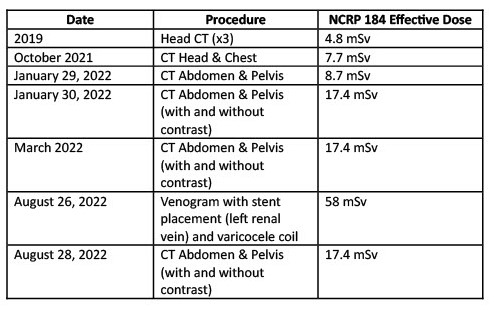Answer to Question #15101 Submitted to "Ask the Experts"
Category: Medical and Dental Patient Issues — Diagnostic X Ray and CT
The following question was answered by an expert in the appropriate field:
I am a tall, skinny, male, about 63.5 kg (140 pounds). I have had multiple computed tomography (CT) scans and am worried about the leukemia risk and cancer risk from these scans. I don't want to start a family and then in 15 years be dead from cancer due to these scans. What is my risk? Should I be concerned? I was told for skinny people the radiation passes through us more quickly. Is this true?
My scans were: (1) three head CT scans, done within seven days in December 2019, (2) one CT scan of head and chest in October 2021, (3) one CT of abdomen and pelvis on 29 January 2022, (4) CT abdomen and pelvis set with and without contrast in January 2022, (5) CT abdomen and pelvis set with and without contrast in March 2022, (6) venogram with stent and varicocele coil placement in August 2022 and (7) CT abdomen and pelvis set with and without contrast in August 2022.
There are many unknowns to consider when thinking about the future, especially when it comes to family planning, but your imaging procedures have not ruined your plans before they've begun. It is important that we acknowledge the overall lifetime risk of developing cancer in the United States general population is approximately 40%. Individual risk is highly influenced by many variables such as personal habits, family history, and living environment. Medical imaging plays a rather inconsequential role in this individual risk for the vast majority of people. Using the information that you provided, let's estimate the total effective dose. There are numerous factors that go into calculating dose from an imaging procedure. To assist in the estimate we will use values from the National Council on Radiation Protection and Measurement (NCRP) Report No. 184, "Medical Radiation Exposure of Patients in the United States." This report provides average effective doses from medical exposures and allows for us to estimate the effective dose from your procedures in milliSieverts (mSv).
Using the NCRP Report, I've created the table below using the information you provided about your medical imaging.

I do want to emphasize two points here: (1) All of the above are estimates and not specific to your imaging. You are also correct in your statement regarding "skinny people," in that it generally requires less radiation to produce an image for smaller patients so the estimates above are likely to be higher than your actual effective dose. (2) The venogram procedures have the largest degree of uncertainty and are likely to be overestimated for a smaller patient such as yourself.
The grand total is 131.4 mSv, and likely a bit overestimated. A good way to help put this in perspective is to compare it to the US Occupational Limit for radiation workers which is 50 mSv per year. The estimate from all your procedures is between two and three years of this allowable limit for radiation workers.
To help provide a little more insight, current studies suggest that an effective dose of 100 mSv to every member of a population will increase the lifetime risk of cancer by 1% for that population. It is important to remember that this is not an individual risk but a population risk. If we have a population of 1,000 individuals with an approximate lifetime risk of cancer of 40% then we would expect 400 lifetime cancers. If each of those 1,000 people were exposed to the same amount of radiation from your imaging procedures (~100 mSv) we might then expect 410 lifetime cancers and 590 individuals not to develop cancer.
There is no need to let your past medical imaging weigh into your plans for the future due to the radiation exposure. There are many factors to consider when making plans such as starting a family and the radiation risk from your procedures should not be anywhere near the top of that list.
Bill Hinchcliffe, MS, Health Physics


